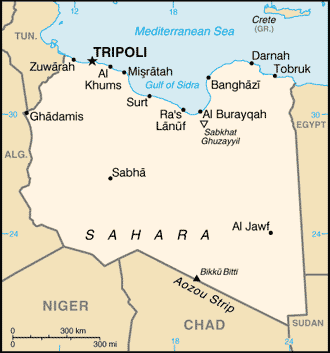
|
Libya (Libyan Arab Jamahiriya)
Background:
Since he took power in a 1969 military coup, Col. Muammar Abu Minyar al-Qadhafi
has espoused his own political system - a combination of socialism and Islam -
which he calls the Third International Theory. Viewing himself as a
revolutionary leader, he used oil funds during the 1970s and 1980s to promote
his ideology outside Libya, even supporting subversives and terrorists abroad
to hasten the end of Marxism and capitalism. Libyan military adventures failed,
e.g., the prolonged foray of Libyan troops into the Aozou Strip in northern
Chad was finally repulsed in 1987. Libyan support for terrorism decreased after
UN sanctions were imposed in 1992. Those sanctions were suspended in April 1999.
Location:
Location: Northern Africa, bordering the Mediterranean Sea, between Egypt and
Tunisia.
Area: Total: 1,759,540 sq km.
Area - comparative: Slightly larger than Alaska.
Land boundaries: Total: 4,348 km, border countries: Algeria 982 km, Chad 1,055
km, Egypt 1,115 km, Niger 354 km, Sudan 383 km, Tunisia 459 km.
Coastline: 1,770 km.
Climate and Terrain:
Climate: Mediterranean along coast; dry, extreme desert interior.
Terrain: Mostly barren, flat to undulating plains, plateaus, depressions.
Natural resources: Petroleum, natural gas, gypsum.
Geography - note: More than 90% of the country is desert or semi desert.
People:
Population: 5,499,074, note: includes 166,510 non-nationals.
Ethnic groups: Berber and Arab 97%, Greeks, Maltese, Italians, Egyptians,
Pakistanis, Turks, Indians, Tunisians.
Religions: Sunni Muslim 97%
Languages: Arabic, Italian, English, all are widely understood in the major
Government:
Government type: Jamahiriya (a state of the masses) in theory, governed by the
populace through local councils; in fact, a military dictatorship
Capital: Tripoli
Economy overview:
The socialist-oriented economy depends primarily upon
revenues from the oil sector, which contribute practically all export earnings
and about one-quarter of GDP. These oil revenues and a small population give
Libya one of the highest per capita GDPs in Africa, but little of this income
flows down to the lower orders of society. Import restrictions and inefficient
resource allocations have led to periodic shortages of basic goods and
foodstuffs.
Statistics:
Telephones - main lines in use: 500,000.
Telephones - mobile cellular: 20,000.
Radio broadcast stations: AM 16, FM 3, shortwave 3.
Radios: 1.35 million.
Television broadcast stations: 12 (plus one low-power repeater).
Televisions: 730,000.
Internet users: 20,000.
Railways: 0 km.
Highways: Total: 83,200 km, paved: 47,590 km, unpaved: 35,610 km.
Airports - with paved runways: 58, with unpaved runways: 78.
Heliports: 1.
Return to Visiting Locations
|

